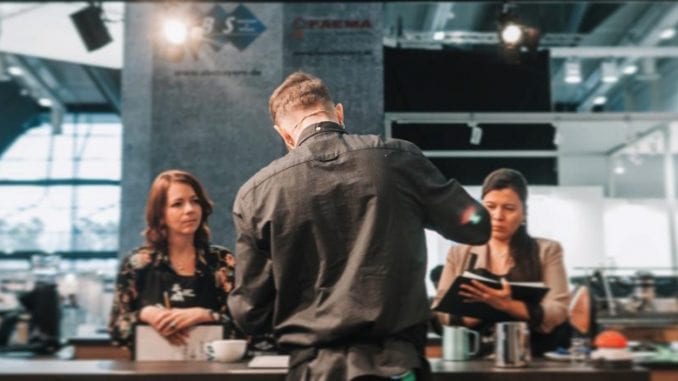
We learn more about Yuri Marschall, the reigning latte art champion from Germany, and how he plans to prepare for the World Latte Art Championship in June.
BY CAROLINE CORMIER
SPECIAL TO BARISTA MAGAZINE ONLINE
Photos by Sinan Muslu
Yuri Marschall will be representing Germany at the World Latte Art Championship in Berlin this June. He got his start in coffee in 2012, when he worked for a design hotel in Hamburg. Combining his newfound passion for specialty coffee with his love for drawing, he began practicing latte art on his own. Three years later, he found himself working at Elbgold Roastery, where he improved his latte art skills further and entered his first competition in 2016. Today, you can find him serving up his designs at Drilling Distillery in Hamburg.
In this interview, we talk to Yuri about how he got started, his passion for latte art, and how he’s preparing for the upcoming World Latte Art Championship.
Caroline Cormier: Can you tell us a little more about how you got interested in specialty coffee and, in particular, latte art?
Yuri Marschall: In 2012, I worked for a design hotel in Hamburg behind the bar. This was the first time in my life that I had worked with specialty coffee and latte art. In my spare time, I spend a lot of time drawing, so I was immediately addicted to latte art. I started to watch videos on YouTube and trained myself to get better. After about three years, I changed jobs and started working for Elbgold Roastery, also in Hamburg.
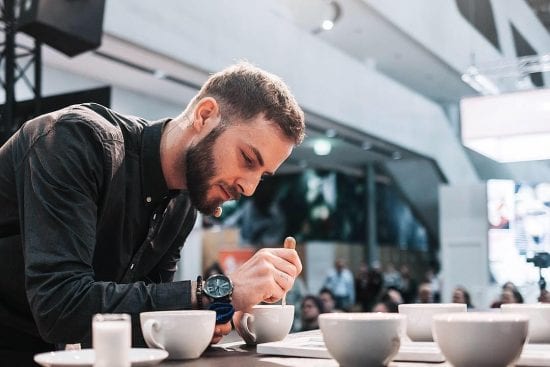
It was at Elbgold that I first discovered the world of coffee championships. In 2016, I took part in my first German championship. I also started participating in a lot of latte art jams and throwdowns to become more confident on stage. This year, after three times competing in the national championship, I finally became Germany’s latte art champion.
Actually, we first spoke just days after you won the 2019 German Latte Art Championship, and you were still in disbelief. How does it feel now that you’ve had some time for the news to sink in?
Perhaps it is a strange thing to say, but it feels normal for me now. I don’t feel special for having won. In fact, it was just about reaching my own goal. I wasn’t doing it for anyone else, or for any other reason. I was just doing what makes me happy.
Has anything changed for you since you brought the title back to Hamburg? Are people asking for their lattes to be made specifically by you?
Life has only changed a little bit for me. Some people have asked me about winning the title, while others don’t even know that I participated in a championship. I get the most attention online, but in real life, I’m just a barista who loves what he does and serves people tasty, and of course beautiful, coffee.
Can you share with us a little bit about how you’re preparing for the World Latte Art Championship coming up in June?
It probably sounds a little boring, but every day I do the same thing. I pour my patterns over and over again. I try to improve them, and my own skills, to create the best result into the cups. I show them to others and talk about the mistakes I’ve made as part of my training. To be honest, I think that my biggest problem will be quieting my nerves on stage. My shaky hands have always been one of my biggest problems.
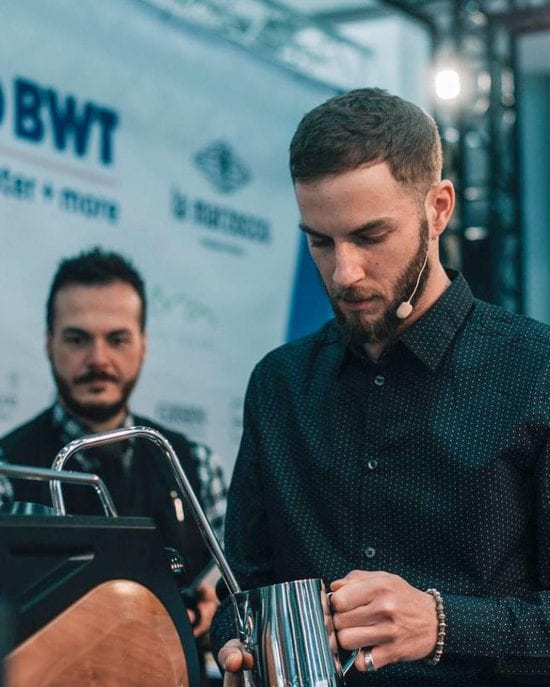
If you were to win the World Latte Art Championship in June, are there things you would do differently going forward, or would you just try to continue with business as usual?
I think I would simply keep doing things as usual. I’m always working on myself and getting better at my craft. The only thing that might change is that I would have the possibility to travel around the world and share my passion with other young and curious baristas. I’d absolutely love to have that opportunity.
For the German Latte Art Championship back in January, you took inspiration from a song off the soundtrack for The Good, the Bad and the Ugly for your designs. Can you tell us a little bit about the process of taking an idea and putting it into a cup? In your opinion, what makes a good—or even great—latte art design?
Actually, I just heard the song one day and the idea came to me to use it as inspiration in the Latte Art Championship. Pulling themes from the song, I wrote down my best ideas and started drawing the first sketches on paper. Of course, it’s not easy to create a pattern which you can pour, rather than just drawing. When you draw, nothing is impossible. It’s just your own imagination that can hold you back.
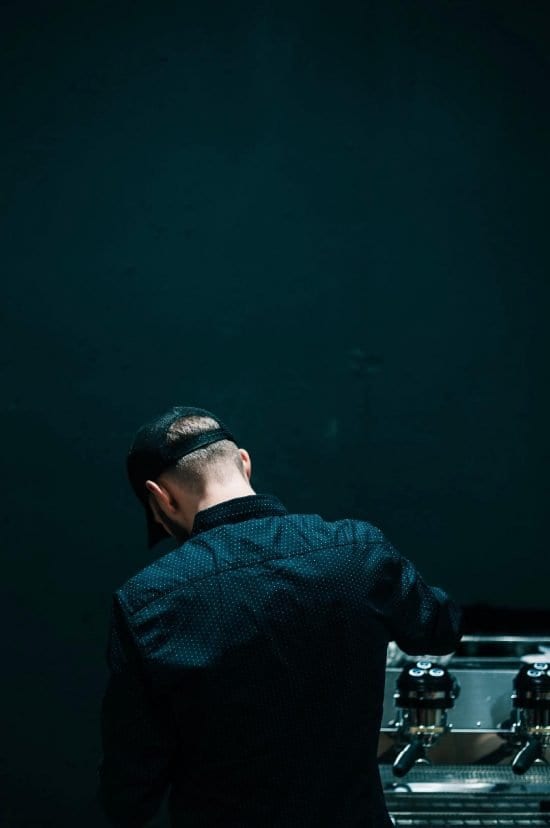
Creating a latte art pattern contains a lot of rules. For instance, you have to consider things like the volume of the cup, the time required, and [having] the skills to create something just by pouring. As part of the process, then, I have to simplify the drawings and find out which parts of the pattern are necessary to make the design look complete. After that, I try to harmonize the single parts of the design to the shape of the cup. For me, these are the most important things to work on when you’re creating a great latte art pattern.
Do you have any advice for young baristas hoping to get into the field? Particularly with regard to improving their latte art skills?
I actually taught myself how to do latte art. I watched a lot of videos on YouTube or Instagram. Seeing how the professionals do their work is really important. You need to be able to watch for the details and then try to copy it on your own.
Most importantly, however, is that when you first start out with latte art, you have to be sure that the basic patterns can be poured blind. These techniques are the base for almost every difficult pattern. Once you master the basics, you can start pouring more complex designs. Of course, not everything will come out perfectly in the first pour. You have to practice over and over again until it works.
I also highly recommend going to different competitions. This includes bigger ones, but also smaller, more local ones. Take every chance you can get to see baristas in action. There are always baristas who will help you out by showing you some new techniques or telling you why what you’re doing doesn’t work when you do it. At the national championships, the most helpful thing is the debriefing after the competition. There is no better chance to get professional advice than this.
Finally, I think it’s important to remember that every one of “us” started at the same point, clueless and at the bottom. If you want to get better, you have to learn by doing.
OK, last question. When you, as Germany’s latte art champion, are working at Drilling, what’s your go-to pour?
This depends on the person who ordered and the drinks that they want. In this case, size matters. In a big cup, I’m able to make the most difficult designs possible. So, sometimes I create intricate flowers or a rose. I also use the classic swan in different variations. I do my best to ensure that every customer has an unforgettable visit to our café.
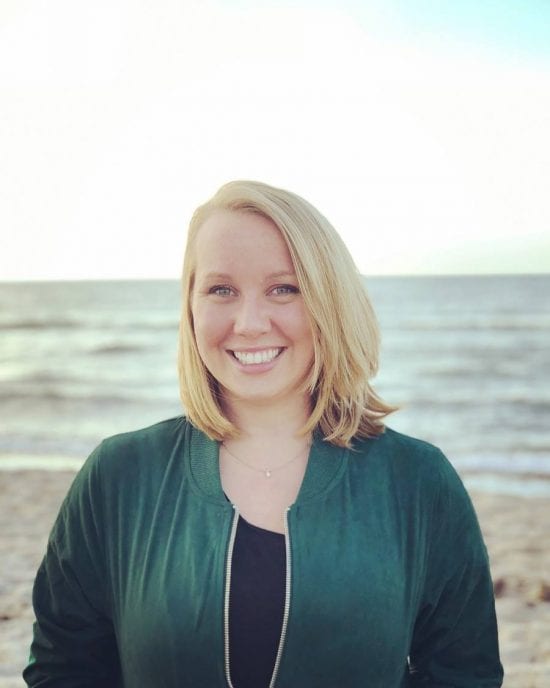
ABOUT THE AUTHOR
Caroline Cormier is a freelance writer from Canada. She currently lives in Berlin, where you can find her digging through archives to discover forgotten stories of the past for her Ph.D., exploring the city’s art and culture scene, or simply enjoying a good cup of coffee at a local café or farmers market.

